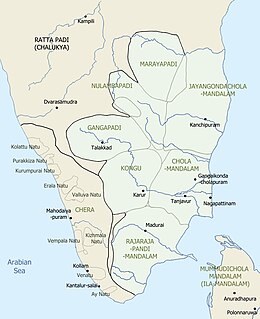
Aditya I, the son of Vijayalaya, was the Chola king who extended the Chola dominions by the conquest of the Pallavas and occupied the Western Ganga Kingdom.

Venad was a medieval kingdom lying between the Western Ghat mountains and the Arabian Sea on the south-western tip of India with its headquarters at the port city of Kollam/Quilon. It was one of the major principalities of Kerala, along with kingdoms of Kannur (Kolathunadu), Kozhikode and Kochi (Perumpadappu) in medieval and early modern period.

The Chera dynasty was one of the principal lineages in the early history of the present day states of Kerala and Tamil Nadu in southern India. Together with the Cholas of Uraiyur and the Pandyas of Madurai, the early Cheras were known as one of the three major powers (muventar) of ancient Tamilakam in the early centuries of the Common Era.

Mushika dynasty, also spelled Mushaka, Tamil/Malayalam: Eli or Ezhi, was a minor dynastic power that held sway over the region in and around Mount Ezhi (Ezhimala) in present-day Kerala, south India. The country of the Mushikas, ruled by an ancient lineage of velir-level chieftains of the same name, appears in early historic (pre-Pallava) south India. Early Tami poems contain several references to the exploits of Nannan of Ezhimalai. Nannan was known as a great enemy of the pre-Pallava Chera chieftains. The clan also had matrimonial alliances with the Chera, Pandya and Chola chieftains.

Rama Varma, with title Kulasekhara PerumalChakravarthikal, was the last ruler of the Chera Perumal dynasty of medieval Kerala. He was a contemporary to Chola kings Kulottunga I (1070–1120) and Vikrama Chola. Rama Kulaskehara is best known for recovering Kollam-Trivandrum-Nagercoil region from the powerful Chola empire around 1100 AD.

The battle of Kandalur salai, also spelled Kanthaloor shala, was a naval engagement of the Cholas under Rajaraja I against the "salai" at Kandalur in south Kerala. The exact location of Kandalur—somewhere south Kerala—is a subject of scholarly debate. The above event is sometimes assumed to be identical with the "conquest of Vizhinjam by a general of Rajaraja", before the burning of Lanka, given in the Tiruvalangadu Grant/Plates.

Ay dynasty, also known as Kupaka in medieval period, were an Indian ruling lineage which controlled the south-western tip of the peninsula, from the early historic period up to the medieval period. The clan traditionally held sway over the harbour of Vizhinjam, the fertile region of Nanjinad, and southern parts of the spice-producing Western Ghat mountains.

Rajasekhara, identified with Rama Rajasekhara, was a Chera Perumal ruler of medieval Kerala, south India. Rajasekhara is usually identified by historians with Cheraman Perumal Nayanar, the venerated Shaiva (Nayanar) poet-musician. Two temple records, from Kurumattur, Areacode and Thiruvatruvay, Vazhappally, mention king Rajasekhara.
Maravarman Rajasimha II was the last major king of the early medieval Pandya kingdom of south India. He was the son and successor of Parantaka Viranarayana. He is the donor of the Larger Sinnamanur Plates.
Kulasekhara is a south Asian male name, used as both given and last name, prevalent in Tamil Nadu, Kerala and Sri Lanka.

Rajaditya Chola was a Chola prince, son of king Parantaka I and a Chera/Kerala princess, known for commanding the Chola troops in the battle of Takkolam.

Sthanu Ravi Varma, probably known as the Kulasekhara, was the Chera Perumal ruler of Kerala in southern India from 844 to c. 870/71 AD. Sthanu Ravi is often identified with playwright king Kulasekhara Varma, and with Bhakti saint Kulasekhara Alvar.

Vikramaditya —better known as Vikramaditya "Varaguna"—was a monarch of the Ay dynasty of south India. His surname indicates that he was a vassal or feudatory of the Pandya ruler Varaguna II. He was the immediate successor of Karunantatakkan "Srivallabha", a vassal of Pandya king Srimara Srivallabha.

Thiruvalla copper plates, also known as the Huzur Treasury Plates, are a collection of medieval temple committee resolutions found at the Sreevallabha Temple, Thiruvalla, Kerala. The collection of plates, engraved in old Malayalam language in Vattezhuthu with some Grantha characters, can be dated to 10th and 11th centuries AD.

Cheraman Perumal Nayanar, one of the sixty-three Nayanars, was a bhakti poet-musician and religious teacher from medieval south India. Historians tentatively identify the Perumal with Rajasekhara, the 9th century ruler of the Chera Perumal kingdom of Kerala.

Ko Kizhan Adikal Ravi Neeli was the traditional title of the queens/princesses of the Chera/Perumal kingdom in medieval south India. It was initially assumed that Kizhan Adikal was a proper given name.

Vazhappally copper plate is a copper plate inscription in Malayalam language from Vazhappally, in the state of Kerala, south India. It is one of the earliest available epigraphical records mentioning a Chera Perumal ruler of Kerala. Recent scholarship puts the date of the plate in c. 882/83 AD.

Vellan Kumaran, diksa name Chaturanana Pandita, was a Kerala commander in the Chola army and a close confidant of prince Rajaditya. He was probably one of the few Chola commanders to have survived the battle of Takkolam in 948/49 AD. Kumaran is best known for engraving his own tragic autobiography in an inscription at Tiruvotriyur, Madras.

Chera/Perumals of Makotai, also known as the Perumal dynasty of Kerala, or Cheraman Perumal dynasty of Mahodayapuram, were a ruling dynasty in present-day Kerala, south India. Makotai, or Mahodayapuram, the seat of the Cheraman Perumals, is identified with present-day Kodungallur in central Kerala. Initially, their influence appeared limited to the area between present-day Quilon and Quilandy, but later extended to up to Chandragiri river in north Kerala and to Nagercoil in the south.

Kongu Chera dynasty, or Cheras/Keralas of Kongu/Karur, or simply as the Chera/Kerala dynasty, were a medieval royal lineage in south India, initially ruling over western Tamil Nadu and central Kerala. The headquarters of the Kongu Cheras was located at Karur-Vanchi (Karur) in central Tamil Nadu. The Chera rulers of Kongu were subordinate to or conquered by Chalukya, Pallava and Pandya kings. Rashtrakuta and Chola rulers are also said to have overrun the Kongu Chera country.
















